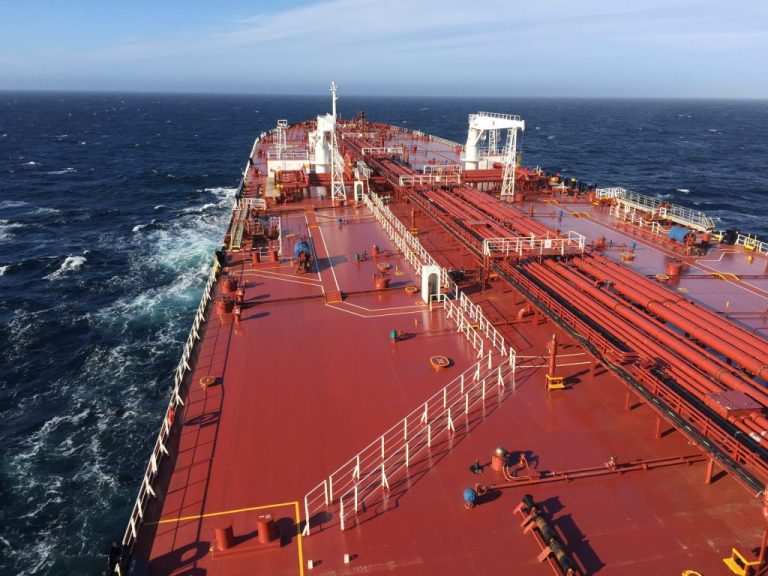
View from the bridge of the Australian Spirit
Karen Campbell, a current a naval architecture and marine engineering (M.Eng.) student, recently had the opportunity to go onboard one of Teekay’s conventional crude vessels, the MT Australian Spirit. Over the course of 13 days, she had a front seat view at a vessel in action once it left the shipyard – and also got a glimpse into what life is like at sea. She has written a series of blog posts about her experience, the second of which is below. We hope you follow along as she talks about touring the ballast tanks, mealtimes, work-life balance, community and family onboard, social activities, living on a tanker, and being in the bridge while sailing into port.
It’s Saturday afternoon and we’re steaming along somewhere off the coast of Nova Scotia. I spent the morning working on my technical report and whale watching on the bridge. Now I’m standing about midship near the cargo manifold on deck. For my benefit, the Chief Officer has organized a walk-through of one of the ballast tanks. Fortunately the weather is nice and the sea is fairly calm. We’ve already been through the safety pre-meeting and sign off. We trade off our regular steel-toes for steel-toed rubber boots and put on harnesses and personal atmosphere detectors. The chief officer has a walkie-talkie, and one of the crew is on hole-watch for us, and has another walkie-talkie to check in with us every level we go down.
There are 12 main water ballast tanks (WBTs) onboard, which line up with the 12 main cargo oil tanks (COTs). Six of each on each side. The WBTs are empty when the ship is loaded with cargo, and are filled with seawater as cargo is discharged to keep the ship at a safe draft. They wrap around the cargo tanks, effectively acting as a double-bottom. If a cargo tank develops a leak, it will leak into the ballast tank and a gas-monitoring system (a bit like the ones we have attached to our boiler suits, but permanent) will go off in the cargo control room and bridge. Since we’re loaded with cargo, the tanks are currently empty.
I switch on the intrinsically safe headlamp on my hard hat and follow the chief officer over the combing on deck and down a short ladder to a landing. The sunlight coming through the entrance hatch lights up the landing, but there’s a lot more volume to inspect. We continue down a set of stairs.
As we walk through each level of the ballast tank, the Chief Officer answers my questions about the structure, features, use, and maintenance of the tanks. It’s strange to see anodes (used to protect the structure against corrosion) on non-submerged structure and realize that the large spaces we’re in are often full of seawater. Other signs like the grated holes in the steel plate underfoot also remind me that the space we’re walking through is primarily designed to hold liquid, not people.
We continue down. We’ve left any light from the manhole far above far behind and have reached the bottom of the hull. We are now climbing over beefy longitudinal girders towards the keel of the ship. It’s a bit surreal to realize that I am some 6 or 7 meters under the surface of the Atlantic and that there is a large tank of crude oil above my head.
The chief officer has an approved camera, but it’s hard to take good pictures in the dark cavern-like environment. It’s half like being in a cave, half like being in a dark, steel cathedral. On our way out, I learn about the set-up of the ballast pipes and stripping system, the hydraulic lines that control valve actuators, and the different sounding tubes in the tank. I remark that there is surprisingly little vibration in the tank compared to some of the vibration I’ve noticed earlier throughout the superstructure.
After the tour, I am directed to the laundry room. I use the washer and dryer set that is meant only for dirty boiler suits. The distinction between the two sets of machines makes perfect sense, but relative to some of the suits I’ve seen around, mine is still pretty clean!
Original story: Exploring the Ballast Tanks
To read more about Karen’s experience, read her next blog post here.